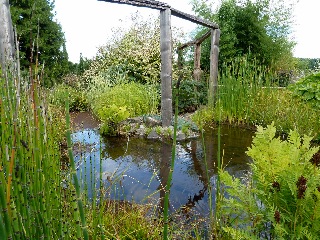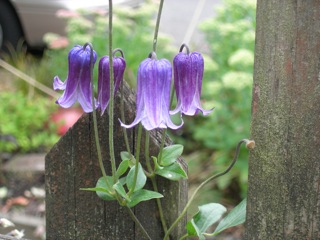

Contributor
- Topics: Archive
Enjoy this virtual road trip and slideshow of images of three specialty nurseries in Oregon which offer fine plants, knowledgeable help, and inspirational garden.
Nurserymen who collect seed in the wild build deep visual reserves they can later draw from. Memories of Manzanita or tan oaks in situ translate into correct garden placement in urban environments. These three Oregon specialty nurseries, stocked with native plants improved by careful and attentive selection, invite gardeners to co-create landscapes inspired by those original memories.
Dancing Oaks
Located just outside of Monmouth, Oregon, Dancing Oaks is situated in the Willamette Valley surrounded by hills crested with garry oak (Quercus garryana). The land was once a dairy farm before being put to use as a World War II training base. Today, Fred Weisensee and his partner Leonard Foltz lease the land from Fred’s family and have created a destination nursery and garden.
When he’s not tending the nursery, Fred is a physician at Good Samaritan Internal Medicine in Corvallis. Leonard, although quiet, is the powerhouse behind the operation, attending to the mechanics of running the nursery. The two men grew up across the valley from one another and are farmers by inheritance. They deeply understand this soil, this climate, and their community. Their commitment to place and history shows in their garden. Dancing Oaks employs as many as seven seasonal employees that work alongside Leonard and Fred to grow and sell a variety of herbaceous and woody plants.
Because I am interested in Siskiyou natives, a large scree area caught my eye. Whimsically referred to as “Mt. Marcos,” and furnished with large metal tractor parts used by the cats as a jungle gym, the bed is planted out with manzanita (Arctostaphylos) cuttings collected by Fred, Leonard, and co-hort Neil Bell, a community horticulturist for Marion and Polk counties. At the time of my visit in July, Rhodohypoxis baurii and yerba mansa (Anemopsis californica) were both in bloom. With the exception of tunneling voles heaving roots in the loose soil amended and mulched with gravel, this field test planting of wild collected plants has been successful.
I bought a ‘Triple Crown’ blackberry after seeing the thick, thornless canes bearing profusely. Other take-away plants included an umbrella leaf (Diphylleia cymosa) for our water seep back home, a toad lily (Tricyrtis formosana) that tolerates shade, and my favorite—probably because I have yet to kill it—a climbing monkshood, (Aconitum hemsleyanun), that blooms through the winter months on my porch in Seattle.
A central pavilion is available for hosting special events and weddings with a trail that leads to an ancient oak covered in crimson glory vine (Vitis coignetiae), an ornamental Japanese grape. In the other direction, along a path bordered by loops of jute netting typically used for erosion control, is a sunny display garden filled with bees, a three-legged greyhound, Maine Coon cats, and a variety of chickens. Along with everything else, Leonard sells eggs and baby chicks. The hatchery is in an old trailer where Fred and Leonard lived for three years while their home on a nearby hill was completed.
The house, designed by James Givens of Eugene, is filled with exquisite details like a light fixture that projects an intricate pattern on the dome-shaped ceiling and a chef’s kitchen. Another path leads to a yurt/guest house passing an acre of vegetables, including a huge potato patch that feeds the staff.
[sidebar]
Truls’ tips for cultivating alpines are:
- Focus on improving air circulation, providing a deep root run, and decreasing soil fertility to successfully grow alpines in wet-winter lowlands.
- Plant alpines in fall when conditions are dry to prevent soil compaction; they require plenty of oxygen at root level.
- Build a successful porous scree soil by combining 40 percent coarse sand, 40 percent quarter ten crushed rock, and 20 percent manure-free, coarse compost.
- Grow alpines that need especially sharp drainage, like Dryas drummondii, in pure sand.
- Keep plant crowns dry with inorganic gravel mulch to prevent fungal disease. [/sidebar]
Wild Ginger Farm
Fred and Leonard generously introduced me to Emma Elliott and Truls Jensen, owners of Wild Ginger Farm, a specialty nursery located in Beavercreek southeast of Portland. Wild Ginger Farm specializes in dryland plants, an interest cultivated while observing plants in their natural habitat when Emma and Truls lived in southern Utah. At a recent Native Alpine Rock Garden Society (NARGS) lecture, Truls showed a photo of a thousand-foot-tall red rock cliff; their adobe house situated at the base of the cliff looked like a tiny dot in the huge landscape.
Winter rains at Wild Ginger Farm exceed 50 inches but, like in much of the Pacific Northwest, late summer brings drought conditions. An old pasture shallowly tilled and mulched with rock, supports a successful dry summer display garden planted with Antennaria, Lewisia, Penstemon, Saxifraga, and other alpines that require well-drained soil. Truls’ masonry work and Emma’s careful plant placement evokes high-elevation landscapes with natural planting crevices. Emma maintains a collection of choice alpines planted directly in tufa, a calcium-rich, porous rock that retains moisture to keep roots cool in summer.
In addition to growing and selling alpines, Wild Ginger Farm specializes in Pacific Coast iris.Emma is currently propagating and hybridizing over a thousand seedlings she’s growing and evaluating for color, form, vigor and hardiness.
Academics by training, Truls (entomology) and Emma (clinical social work) farm by choice and bring a scientific mindset to the process, always testing their assumptions and trialing dryland plants under different conditions. That information, including precise soil mixes and anecdotal information culled from years of experiences, is generously passed along to their customers.
I learned that Lewisia tweedyi must remain bone dry in winter; explaining why my plants survived for three years sheltered from the rain in a pot on my deck, only to languish when planted out in an exposed scree bed that receives winter precipitation.
Emma and Truls maintain the nursery and beautiful display area by themselves and I found the health of their plants impressive. Though a significant proportion of their business is mail order, my two visits to the nursery were a real treat and an education.
Joy Creek
Another Oregon favorite, Joy Creek Nursery, lies west of Portland. Owners Maurice Horn and Mike Smith promote hardy plants that thrive in austere environments like those inhospitable parking strip beds found in so many urban neighborhoods and often referred to as “hell strips.”
Mike and Maurice focus on building good soil and do not believe in overfeeding perennials. In Joy Creek display gardens only delphiniums, roses, and lilies receive a slow-release fertilizer.
Mike revealed his eccentric and untraditional pruning method for training a dwarf ‘Thundercloud’ Japanese black pine (Pinus thunbergii ‘Thundercloud’) by “caning” the candles—new growth—in spring. This control method that is more commonly used on unruly English school boys has resulted in a beautifully twisted and asymmetrical form. In contrast to this discipline waged with a stick, Mike’s advice to gently lift foxtail lilies (Eremurus spp.) every three years, delicately teasing the soil from between their roots, helped me understand how rough I’ve been with my spading fork.
Like at so many specialty nurseries, plants are served up at Joy Creek Nursery with valuable cultural information to ensure success. A liberal arts education as well as a horticultural one was in the offing as I observed spiny bear’s breeches (Acanthus hungaricus and A. spinosa) growing in the spike garden. Mike assured me the two species are better behaved plants than the more common, sometimes invasive, A. mollis whose iconic foliage is depicted on early Corinthian columns and decorates the crown of New York’s Chrysler Building.
In addition to the drought-tolerant plants that the nursery is known for, Maurice is passionate about clematis, one of the major plant collections on display and for sale at the nursery. He is deeply involved with the International Clematis Society and clematis growers and breeders in Europe and Japan. His relationship with Kazushige Ozawa, a Japanese clematis specialist, led to the gift of the bestselling Clematis ‘Roguchi’ for distribution to the North American market. Clematis breeding at Joy Creek focuses on selecting plants grown from seed, a lengthy process that takes at least seven years to mature and evaluate seedlings. They have released very few of their own clematis selections although, according to Maurice, several are in the works.
Both men apply their extensive plant knowledge to designing landscapes filled with sensory pleasure. Roses create fragrant tunnels where the aromas of green apples (Rosa eglanteria) and talcum powder (R. ‘Theresa Bugnet’ and R. ‘Boule de Neige’) are woven together with blooming clematis and flowering hydrangeas.
The owners of the three nurseries I visited specialize in plants that fit a specific garden niche. They generously share their knowledge and passion for plants with others. Like a well-rooted Lewisia tweedyi adapting to pot culture on my front porch, knowing when to provide unique conditions for a treasured plant can spell the difference between success and disappointment.
Dancing Oaks Nursery
17900 Priem Road
Monmouth, OR 97361
503-838-6058
https://www.dancingoaks.com/
Wild Ginger Farm
24000 S Schuebel School Rd
Beavercreek, OR 97004
503-632-2338
https://www.wildgingerfarm.com
Joy Creek Nursery
20300 NW Watson Road
Scappoose, OR 97056
503-543-7474
Share:
Social Media
Garden Futurist Podcast
Most Popular
Videos
Topics
Related Posts

Low Maintenance Gardens – Better for Pollinators and People
Autumn 2022 “I come out every day. It’s therapy, my meditation.” Janet’s young garden transformed from overgrown, invasive plants to mostly natives. The dailiness of

Calochortophilia: A Californian’s Love Affair with a Genus
Summer 2022 I can chart the progression of my life by Calochortus. For the last two decades, at least. As a teenage girl growing up

Pacific Plant People: Carol Bornstein
Spring 2022 Public gardens play a key role in demonstrating naturalistic planting design, selecting native and adapted plants for habitat, and testing techniques for reducing

Add Year-Round Interest and Winter Blooms for Pollinators
Spring 2022 This article was created from an Interview by Merrill Jensen with Neil Bell in the Summer of 2021 for our Pacific Plant People




























Responses